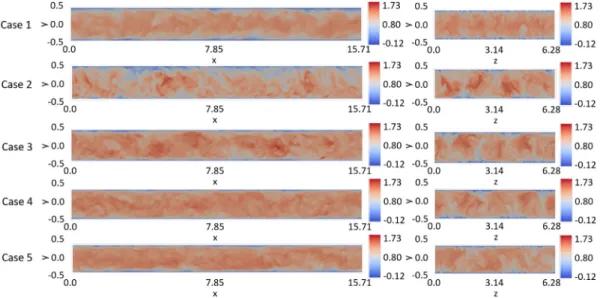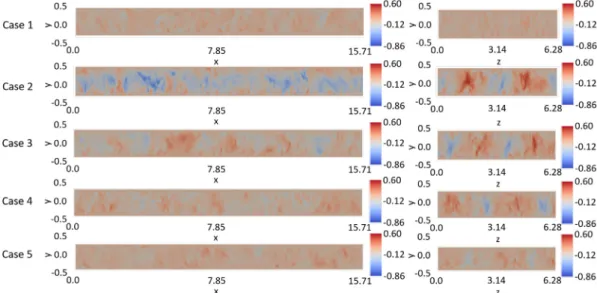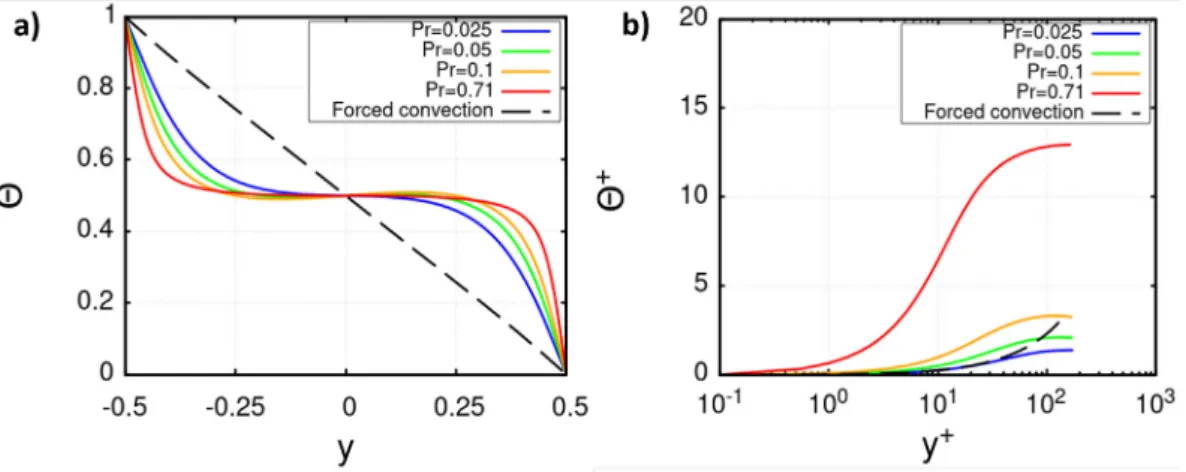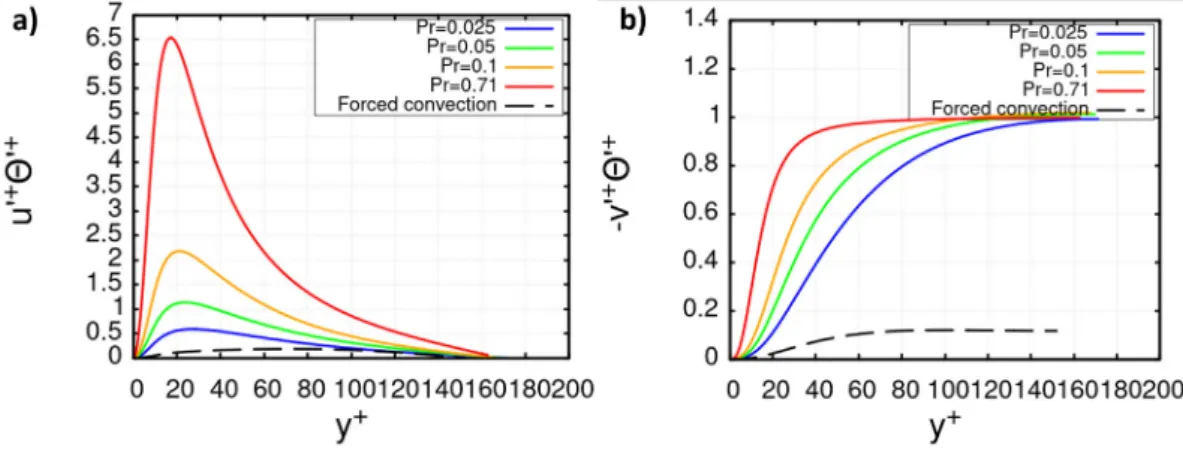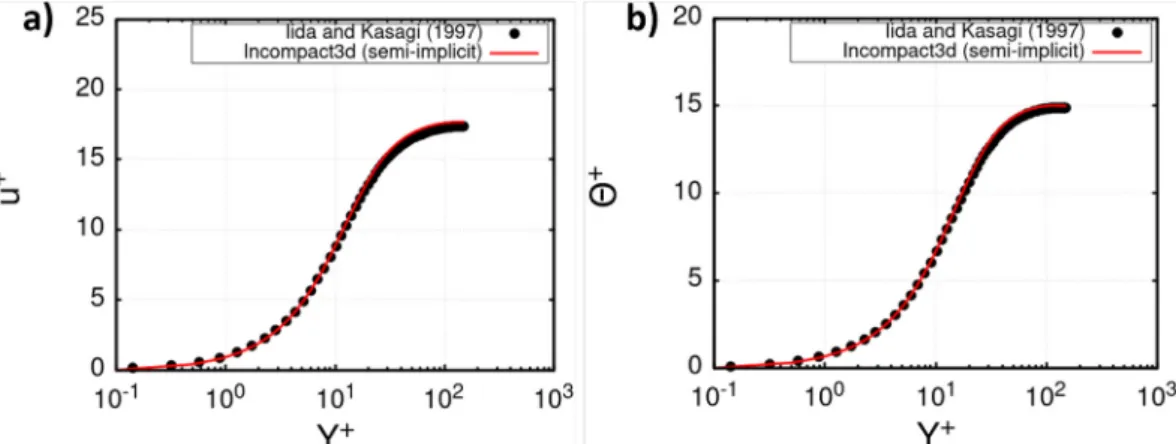Research Collection
Journal Article
Mixed convection study on the influence of low Prandtl numbers and buoyancy in turbulent heat transfer using DNS
Author(s):
Guo, Wentao; Prasser, Horst-Michael Publication Date:
2021-08
Permanent Link:
https://doi.org/10.3929/ethz-b-000479183
Originally published in:
Annals of Nuclear Energy 158, http://doi.org/10.1016/j.anucene.2021.108258
Rights / License:
Creative Commons Attribution-NonCommercial-NoDerivatives 4.0 International
This page was generated automatically upon download from the ETH Zurich Research Collection. For more information please consult the Terms of use.
ETH Library
Mixed convection study on the influence of low Prandtl numbers and buoyancy in turbulent heat transfer using DNS
Wentao Guo ⇑ , Horst-Michael Prasser
Department of Mechanical and Process Engineering, ETH Zurich, Switzerland
a r t i c l e i n f o
Article history:
Received 28 November 2020
Received in revised form 31 January 2021 Accepted 10 March 2021
Keywords:
DNS
Turbulent heat transfer Mixed convection Liquid metal
a b s t r a c t
Direct numerical simulation (DNS) is performed to study turbulent heat transfer in Poiseuille-Rayleigh- Bénard (PRB) flows with low Prandtl numbers in this article. The mesh is Cartesian and a highly accurate finite difference sixth-order compact scheme is chosen to discretize the incompressible Navier–Stokes equations to perform DNS. Liquids with a fixed Richardson number of 0.25 and four different Prandtl number (Pr = 0.025, 0.05, 0.1, 0.71) are simulated and compared with Poiseuille flow to investigate the influence of Prandtl number and buoyancy on –PRB flows. Constant fluid properties and Boussinesq approximation are assumed. The obtained results are discussed and analysed in an extensive way in this study. Specifically, buoyancy initiate large scale circulation and the scale shrinks with the increasing of Prandtl number. Velocity fluctuations become stronger with PRB flow which indicate that buoyancy can strongly enhance the turbulent intensity. Re s is increased in the cases of low Pr. Moreover, when Pr decreases, temperature distributions are found to be more homogeneous and mixing of the fluids is more sufficient in the middle of the channel. Additionally, the scale of the large-scale structures is enlarged in mixed convection compared with forced convection. This can be observed in the temperature field of low-Prandtl-number fluids. It is also observed that Reynolds analogy cannot be used to predict the thermal field under mixed convection or forced convection with low Prandtl number. The research results can be used for the R&D of Gen IV nuclear fast reactors.
Ó 2021 The Author(s). Published by Elsevier Ltd. This is an open access article under the CC BY-NC-ND license (http://creativecommons.org/licenses/by-nc-nd/4.0/).
1. Introduction
The heat and momentum transfer caused by the combined effect of buoyancy and shear within a fluid flow is named as mixed convection. This is a classical phenomenon related to heat transfer in nuclear reactors. In some fast nuclear reactors such as sodium- cooled fast reactors (SFR) and lead-cooled fast reactors (LFR), liquid metal is used as coolant. It circulates in the primary circuit under mixed convection conditions and moves the heat generated from the reactor core to the primary heat exchanger. To improve the safety features and efficiency of LFR and SFR, it is important to understand the mixed convection phenomenon of liquid metal, which usually has a low Prandtl number. Mixed convection is the combination of forced and natural convection. However, the result- ing flow field and the heat transfer intensity are not simply the combination of the two. Reynolds-averaged Navier–Stokes (RANS) type turbulent models are helpful to study mixed convection. It can be used for simulating large domains and realistic engineering
problems due to the low cost of computational resources. How- ever, the results from the RANS models need to be validated against experimental or direct numerical simulation (DNS) data before we can trust them. Due to the absence of experimental data on turbulent parameters for liquid metals, such as Reynolds stress and turbulent heat fluxes, RANS approaches can only be validated and compared with DNS data. So far as we know, the RANS models cannot be directly used to simulate the turbulent heat transfer of liquid metals. So new RANS models could be developed from DNS data. In the framework of the EU Horizon 2020 thermal hydraulics Simulations and Experiments for the Safety Assessment of MEtal-cooled reactors (SESAME) project, a series of high-fidelity DNS databases are created. The PRB flow of low-Prandtl-number fluids in a horizontal channel is one of them, which is also the main topic of this article.
In order to study the heat transfer behavior in a turbulent flow, a number of simulations has been performed. As for the forced con- vection, Poiseuille flow is a standard configuration and has been used extensively. It represents the pressure-driven turbulent flow flowing through a plane channel. The DNS of forced convection channel flow started from Kim et al. (1987). Further studies are carried out such as Jiménez and Moin (1991), who studies https://doi.org/10.1016/j.anucene.2021.108258
0306-4549/Ó 2021 The Author(s). Published by Elsevier Ltd.
This is an open access article under the CC BY-NC-ND license (http://creativecommons.org/licenses/by-nc-nd/4.0/).
⇑ Corresponding author.
E-mail addresses: guow@student.ethz.ch (W. Guo), prasser@lke.mavt.ethz.ch (H.-M. Prasser).
Contents lists available at ScienceDirect
Annals of Nuclear Energy
j o u r n a l h o m e p a g e : w w w . e l s e v i e r . c o m / l o c a t e / a n u c e n e
turbulent flows in various narrow boxes without heat transfer.
Zonta et al. (2012) finds that viscosity which depends on tempera- ture can affect turbulence in Poiseuille flow with differentially heated walls. The temperature is regarded as passive scalar and the turbulent heat transfer is with respect to Prandtl number and Reynolds number. Besides, studies with conjugate heat transfer (Flageul et al., 2015; Tiselj and Cizelj, 2012; Tiselj et al., 2001) and imposed thermal boundary conditions (Kasagi et al., 1992;
Kawamura et al., 1999; Tiselj et al., 2001; Bricteux et al., 2012;
Kozuka et al., 2009; Kasagi and Iida, 1999; Pirozzoli et al., 2016) are performed.
As for the natural convection regime, the Rayleigh-Bénard con- vection (RBC) is a prototype case and has been widely studied, both numerically (Grötzbach, 1982; Silano et al., 2010; Scheel and Schumacher, 2016) and experimentally (Otic´ and Grötzbach, 2005; Akashi et al., 2019). The fluid is heated up from bottom and cooled down from top so it is driven by buoyancy. The two controlling parameters for RBC flow are Prandtl and Rayleigh number.
A prototype case for mixed convection study is Poisueille-Ray leigh-Bénard (PRB) flow. In PRB flows, a complex flow structure is produced by the combination of pressure driven (Poiseuille) and buoyancy driven (Rayleigh-Bénard) effects. The structures depend on the relative intensity of Grashof number and Reynolds number. Mixed convection has been investigated both numerically and experimentally, but publications are less frequent as forced and natural convection due to its challenging nature. Iida and Kasagi (1997) build a DNS database to study PRB flow of air with Pr = 0.71. Davidson et al. (2003) performed DNS of fluid flowing in a vertical channel for a unitary Prandtl number. They point
out that the shear stress is strongly affected by buoyancy in mixed convection. Kath and Wagner (2014) studied PRB flows with the smallest acceptable computational box size for a Prandtl number equals to 0.71 using LES and DNS. Zonta and Soldati (2014) used DNS to investigate PRB and Poiseuille flow with Boussinesq and non-Boussinesq assumption with a Prandtl number equals to 3.
Pirozzoli et al. (2016) performed DNS for PRB flows at a unitary Prandtl number in a wide range of Re and Ra numbers. Besides simulations, some experimental studies on unstable stratification effects and PRB flow can be found in Komori et al. (1982), Keisuke and Masamoto (1985) and Keisuke et al. (1991).
As mentioned above, for PRB flows, most studies focus on Pr close to or larger than 1. The experiments for low-Prandtl- number fluids are difficult due to: 1. For Pr < 0 : 2, liquid metals such as mercury, gallium and liquid sodium are opaque. So optical access to the flow by laser-imaging techniques such as laser Dop- pler velocity measurement (LDV) or particle image velocimetry (PIV) are inapplicable; 2. the thermal conductivity of the boundary materials, which are usually copper plates, is not significantly higher than that of the liquid metals. The temperature of the plates varies during the experiment and will change the magnitude of the heat transfer because of the Robin boundary condition (Scheel and Schumacher, 2016). So fundamental experimental studies at isothermal boundary conditions are practically impossible. DNS of PRB flows of liquid metals is also challenging due to the appear- ance of large-scale structures. A larger domain compared to cases with a unitary Prandtl number is necessary for capturing them (Guo et al., 2020; De Santis et al., 2018). This increases the compu- tational cost significantly. This challenge has to be faced in studies of the influence of low Prandtl number and buoyancy on heat Nomenclature
Roman symbols
C p specific heat at constant pressure d r averaged relative difference g gravitational acceleration Nu Nusselt number
Pr Prandtl number
Pr
tturbulent Prandtl number
p pressure
q w wall heat flux Ra Rayleigh number Re Reynolds number Re s friction Reynolds number Ri Richardson number T temperature
T h temperature on the hot wall T c temperature on the cold wall
t time
U b bulk velocity u s friction velocity u ; v ; w velocity component x streamwise direction y wall-normal direction z spanwise direction Greek symbols
a thermal diffusivity
b coefficient of thermal expansion d channel half height
h dissipation rate of temperature variance h non-dimensional temperature
h s friction temperature k thermal conductivity
t kinematic viscosity
q density
g statistical deviation rate Subscripts
()
rmsroot-mean-square ()
wwall value Superscripts
()
+normalized by u s or h s () 0 fluctuation component ðÞ statistically averaged d averaged over Acronyms
CFD computational fluid dynamics CFL Courant-Friedrichs-Lewy DNS direct numerical simulation FTT flow-through times FVM finite volume method
LDV laser Doppler velocity measurement LES large eddy simulation
LFR lead-cooled fast reactor PIV particle image velocimetry PRB Poiseuille-Rayleigh-Bénard
RANS Reynolds-averaged Navier–Stokes equations
transfer for turbulent PRB flows which are needed to build DNS databases for RANS validation.
Most simulation studies mentioned above used spectral method or second-order finite volume method (FVM) to discretize the gov- erning equations. The advantage of the spectral method is that it has a high-order derivative approximation, but it requires the geometry to be simple, and on sharp boundaries it will lose accu- racy. Moreover, implementing physical models in a spectral solver is not easy. The second-order FVM is widely used in commercial computational fluid dynamics (CFD) software. However, when per- forming a DNS study, second-order accuracy schemes are not ideal for equation discretization in space. For simulating small turbulent scales down to the Kolmogorov length scale, the mesh density required is huge. It requires excessive computational resources.
The code used in our DNS study is Incompact3d ( https://www.in- compact3d.com/). It is an open source code developed at the University of Poitiers and Imperial College London by Laizet and Lamballais (2009) and Laizet and Li (2011) It has a superior versa- tility than spectral codes and a higher accuracy than industrial codes. The code uses a six-order-accurate finite difference compact scheme (Laizet and Lamballais, 2009) to discretize governing equa- tions and a hybrid second-order Crank-Nicolson and Adam- Bashforth scheme for the temporal discretization. Crank-Nicolson is an implicit scheme which is only used for treating the second- order derivative in the wall-normal direction.
In this study, the result of several DNS of the mixed convection channel flow at moderate Reynolds number and low Prandtl num- bers are presented. The influence of Pr on PRB flow in a horizontal channel is studied and the results are shown in Section 3. A DNS database of PRB flows for low-Prandtl-number fluids is generated and can be used to analyze the mechanism of heat transfer within liquid metals and to improve and validate RANS models. The data- base follows the creative commons attribution license (CC-By) and it is accessible from the following website: https://doi.org/10.
3929/ethz-b-000468723.
2. Numerical methodology 2.1. Flow configuration
The flow configuration is a horizontal channel which is shown in Fig. 1. An iso-thermal Dirichlet-type boundary condition is applied for the temperature at the wall boundaries. The bottom wall is the hot one and kept at T
h, while the top wall is cold and kept at T
c. The letter d represents the channel half height. This is a typical PRB flow, where the buoyancy forces induced by the tem- perature difference D T
hc¼ ð T
hT
cÞ cause an unstable stratifica- tion (the acceleration of gravity acts downward along y - direction). The letters x ; y and z represent the streamwise, the wall-normal, and the spanwise coordinates respectively. In the x and in z-direction, periodic boundary conditions are applied and in the y-direction, a no-slip boundary condition for velocity is used.
The fluid moves at an imposed constant mass flow rate.
2.2. CFD solver
In our DNS with the code Incompact3d, (1) the Oberbeck- Boussinesq approximation is applied, which means the fluid has uniform thermal-physical properties and (2) the working fluid is assumed to be incompressible. The continuity equation, the momentum equation and the energy balance equation are the gov- erning equations for the simulation and they are defined in a non- dimensional way as:
@u i
@x i ¼ 0; ð1Þ
@u i
@t þ @
@x j
u j u i
¼ @p
@x i þ 1 Re b
@ 2 u i
@x j @x j þ fd i1 þ Ri b d i2 h; ð2Þ
@h
@t þ @
@x j
u j h
¼ 1 Re b Pr
@ 2 h
@x j @x j : ð3Þ
Reference velocity and length are non-dimensionalized by the bulk velocity, U
band the channel height, 2d respectively. The pres- sure is non-dimensionalized by q U
2b. In Eq. (2), fd
i1is added as the momentum source term to keep a constant mass flow rate. f is a time-dependent value. It is constant in space and it is varied in a certain way to keep the averaged bulk velocity at unity. d
ijis the symbol of the Kronecker delta. Ri
bd
i2hrepresents the buoyancy and his the non-dimensional temperature which is defined as h ¼ ð T T
cÞ= D T
hc. The expression of bulk Reynolds number is Re
b¼ 2U
bd = t . The Richardson number and the Grashof number are defined as Ri ¼ Gr = ð Re
bÞ
2and Gr ¼ gb D T
hcð Þ 2d
3= t
2respectively.
The spatial discretization schemes are six-order compact finite difference schemes based on Cartesian grids. The continuity, momentum and energy equations of the working fluid with con- stant properties are solved using a projection method (Flageul et al., 2015):
u
iu
niDt ¼ 3
2 1 2
@ u
niu
nj@x
j1
2 u
nj@ u
ni@x
jþ 1 Re
b@
2u
ni@x
2þ 1 Re
b@
2u
ni@z
20
@
1 A
1 2 1
2
@ u
n1iu
n1j@x
j1
2 u
n1j@u
n1i@x
jþ 1 Re
b@
2u
n1i@x
2þ 1 Re
b@
2u
n1i@z
20
@
1 A
þ 1 Re
b@2u
@y2i
